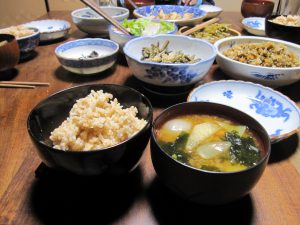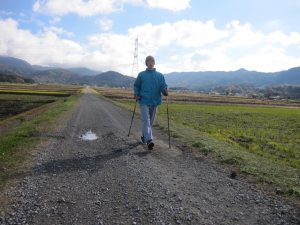Can Ikigai Diet Help Dementia? Part2 What to Eat Every Day
We had another group of junior high school students stay with us, and we ate Takenoko, bamboo shoots. Bamboo shoots are great because they are local, wild, and seasonal plants containing bacteria suitable to our body.
In the last post, I talked about some of the foods which are thought to be good for our brain health, today I would like to share with you what specifically you can have for breakfast, lunch, and supper for your brain health.
As I said in the last post, Ikigai Diet isn’t designed to cure any specific type of disease, nor it is designed to help you lose weight. It is a diet for people in general who want to lead a long, healthy, and happy life. We are looking into a long term lifestyle, not a short term diet program designed for symptomatic treatment. If you have a specific problem, seek the advice of your physician or other qualified health providers first.
It is always better to change your diet when you are still healthy. I especially recommend people in your 50s that you start doing something about your health now. I am in my 50s and I know exactly how you feel. We have parents to look after which makes us think of our own health. We are old enough to start worrying about our conditions and yet young enough to do something about it.
So what can we eat for our brain health?
The bottom line is to eat MA GO WA YA SA SHI I, whole grains, and fruit.
Beans, nuts and seeds, seaweeds, seasonal vegetables, small natural fish, mushrooms, sweet potatoes and taros, and whole grains such as oats and brown rice. You can come up with menus based on those foods. Choose organic ingredients as much as possible including seasonings.
What can you have for breakfast?
There are two options for breakfast.
1, fermented brown rice, shredded cabbage with a poached egg, and miso soup with a lot of vegetables.
Fermented brown rice is one of the best foods for your gut microbiota, it is whole grain and fermented. Having miso soup in the morning warms up your body, and by putting vegetables with dietary fiber and seaweeds, it becomes a superfood of on its own. Raw cabbage provides a lot of enzymes as in raw food, and a poached egg is the most effective way of getting choline.
2, blueberries, muesli with a lot of oats and soymilk or soy yogurt.
If you don’t want to do a lot of cooking in the morning, muesli is an easy way and yet has plenty of health benefits. I would eat blueberries, strawberries when they are in season the first thing in the morning, and then have muesli with soy milk or soy yogurt. I recommend that you make your own muesli so that you can choose the ingredients. Put a lot of oats, nuts, seeds, and dried fruit. When berries are not in season, you can have other seasonal fruit first thing in the morning.
You can have this second option during the week and have the first option on the weekend if you want to avoid a lot of hassle in the morning.
What can you have for lunch?
Lunch can be the biggest meal of the day depending on your working schedule. If it is possible to make it the main meal, it is more beneficial for your health. You can eat all kinds of dishes and you want to have diversity here to make it fun, as well. So think of a menu with a good balance of carbs, vitamins, and protein.
For carbs, you can have brown rice, fermented brown rice, boiled, or steamed potatoes, boiled or steamed sweet potatoes, boiled or steamed taros, corns, wholewheat bread, quinoa, or any other types of grains. As for potatoes, sweet potatoes and taros are better than white potatoes, and yet for many Europeans, white potatoes have been your staple food for centuries, it is possible that some of your gut microbes like potatoes. I wouldn’t rule them out as long as you don’t eat too much of them. When you eat potatoes, eat the skin as well.
For wheat and it goes for other grains, too, it is better to eat wheat berries rather than flour. You can cook wheat berries just like you cook brown rice. If you want to eat bread, make sure that you eat sourdough bread and use wholewheat flour. You can bake your own bread so that you can choose the ingredients. I usually make bread with 60 to 70% whole wheat flour and the rest with nuts, seeds, dried fruit, oats, muesli, or rice.
For vegetables, you can choose locally grown seasonal vegetables, possibly including the ones you can eat raw, too. For vegetables you need to cook, you can boil, steam, or stirfry them. You can season them with herbs. For the salad, you can make a dressing with brown rice vinegar or apple vinegar, olive oil or sesame oil, sesame seeds, and some salt.
For protein, you can have beans or fish, depending on what you had for breakfast. I would limit animal protein to one meal a day. If you had eggs for breakfast, you can have beans for lunch and supper.
What can you have for supper?
Depending on your schedule, supper can be your biggest meal of the day. I said making lunch the main meal was preferable, but social life is important for your mentality, too, so whichever way is comfortable, you can choose it.
The menu for supper is pretty much the same as that of lunch. You can rotate 10 to 20 menus around lunch and supper. If you make lunch the biggest meal of the day, supper can be lighter. You can just have soup and bread, or salad and beans. One thing good to have in the evening though is natto, fermented soybeans. Natto germ can best be taken at night. So, fermented brown rice, miso soup with a lot of vegetables, pickles, and natto would be one of the best supper menus. You can have a glass or two glasses of red wine with them, too.
What can you have for dessert or snacks?
If you can, you can live without them. Stop eating when you are 70% full or 80% full is good for your stomach and intestines. If you have dessert after supper, it can be too much food to digest. I wouldn’t encourage eating between meals either since you want to give enough breaks to your organs. You don’t want to eat after 8 pm, and if you have the urge to put something in your mouth, you can drink some herb tea. Nevertheless, a strict diet cannot last so you can make exceptions from time to time. You can make your own sweets using raw sugar, honey, brown sugar, or other natural syrup. You can have nuts or dark chocolate with over 70% cacao as snacks, too. Cacao is said to be good for the brain. It boosts blood circulation to the brain.
Occasional feast
Just like making exceptions for dessert and snacks, you can make exceptions for your meals, as well, especially on weekends. I believe 70% of your diet affects your health and not 100%. I know a lot of diets out there are strict but I also know that mental stress is one of the biggest causes of diseases. You want to make your diet lose enough for you to continue practicing and making 30% of your diet to give yourself breaks is a way to go.
First, find ways to enjoy your food while keeping it within your diet, but if you can’t do it, you can break rules from time to time.
What is more critical is that you enjoy your dietary culture.

